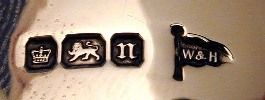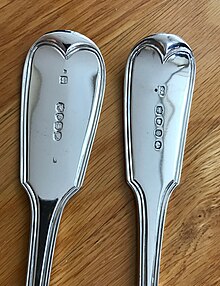|
Silver hallmarks
  A silver object that is to be sold commercially is, in most countries, stamped with one or more silver hallmarks indicating the purity of the silver, the mark of the manufacturer or silversmith, and other (optional) markings to indicate the date of manufacture and additional information about the piece. In some countries, a national assayer's office controls the testing of silver objects and marking of purity. Hallmarks are applied with a hammer and punch, a process that leaves sharp edges and spurs of metal. Therefore, hallmarking is generally done before the piece goes for its final polishing. The hallmark for sterling silver varies from nation to nation, often using distinctive historical symbols, although Dutch and UK Assay offices no longer strike their traditional hallmarks exclusively in their own territories and undertake assay in other countries using marks that are the same as those used domestically. United Kingdom and IrelandOne of the most highly structured hallmarking systems in the world is that of the United Kingdom, (Scotland, England, Wales and Northern Ireland), and Ireland. These five nations have, historically, provided a wealth of information about a piece through their series of applied punches. Since 2015 visually identical UK Hallmarks have been struck in India and Italy by sub-offices of Birmingham and Sheffield Assay Offices respectively: 

The series of hallmarks described above are still in use in today. However, there are two silver hallmarks that have been discontinued:
FranceSince the year 1838, the French assay mark for items made of solid silver is the head of the goddess Minerva in profile. The French have two standards for silver purity or fineness. The higher is 950 parts per thousand, or 95% silver referred to as 1st Standard. The lower grade of silver is 800 parts per thousand, or 80% silver referred to as 2nd Standard. Both standards are marked with the head of Minerva inclusive of a numeral 1 or 2 to indicate the standard. French silver made for export carries an assay mark in the shape of the head of Mercury, along with a number to indicate the millesimal fineness: "1" for .920, "2" for .840 and "3" for .750. French silver also is punched with the mark of the maker, by law in the shape of a lozenge, usually with the maker's initials and a symbol. United StatesIn the early United States, no national assaying system was adopted, although the city of Baltimore did maintain its own assay office between 1814 and 1830.[citation needed] Prior to the general adoption of sterling silver as the standard of purity in 1868, silver was generally obtained from the melting of coins. Since these could vary considerably in purity, from around .750 millesimal fineness to around .900, silver known as "coin silver" varies in purity. Silver at that time was sometimes marked "COIN" or "PURE COIN", but can also be without a standard mark altogether. After the adoption of the sterling standard, pieces were marked with "STERLING", the number "925" or the notation "925/1000".[citation needed] The United States also had no date marking system. Because of this, some companies within the U.S., such as Tiffany, Reed & Barton and Gorham, adopted their own date marking systems.[citation needed] While American manufacturers did not apply assay marks, city marks or date marks, they did apply a maker's mark. This is generally not done today. The old hallmarks were as unique as today's logos, and disputes often arose when one company copied another's stamp.[citation needed] "The words "silver" and "sterling silver" describe a product that contains 92.5% pure silver. Silver products sometimes may be marked 925, which means that 925 parts per thousand are pure silver. Some jewellery described as "silver plate" has a layer of silver applied to a base metal. "Coin silver" is used for compounds that contain 90% pure silver. According to the law, quality-marked silver also must bear the name or a U.S. registered trademark of the company or person that will stand behind the mark."[1] HungaryBetween 1867 and 1933, Austria-Hungary and later, Hungary used the crescent moon crowned head of ancient Greek heroine Diana as the hallmarking symbol of legal silver alloys. The head was encircled by a frame, optionally composed of convex, concave and straight lines. One concave line represented 140/1000 fineness, a straight one 150 and a convex one 160. For example, a Diana head within a frame made in the shape of a 5-petal flower represented 5×160/1000 = 800 thousands fineness, a local silver standard commonly used in table forks and spoons. Meanwhile, a hexagonal frame represented 900 fine silver. This same system was also used to frame gold hallmarks. JapanFrom 1929, Japan Mint assays and hallmarks the articles made of silver. The hallmarks of Japan Mint have the figure of the national flag of Japan. References
External links
|